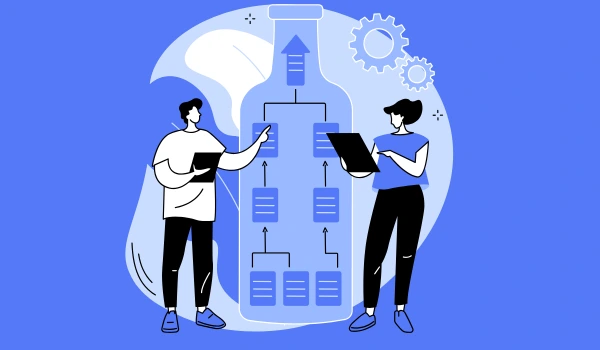
Project Dependency Mapping: A Comprehensive Guide for Effective Project Management
Project Dependency Mapping is the process of identifying and visualizing the relationships and dependencies between tasks, resources, and milestones in a project. It helps project managers anticipate potential bottlenecks, allocate resources effectively, and ensure smooth project execution. By mapping dependencies, teams can prioritize tasks, mitigate risks, and deliver projects on time and within budget.
Table of Contents
- What is project dependency mapping?
- 1. finish-to-start (fs)
- 2. start-to-start (ss)
- 3. finish-to-finish (ff)
- 4. start-to-finish (sf)
- Summary table
- What to include in project dependency mapping
- How to do project dependency mapping
- Tools for project dependency mapping
- Best practices for project dependency mapping
- Why project dependency mapping matters
- Ready to master project dependency mapping?
In the world of project management, success often hinges on the ability to anticipate challenges, allocate resources efficiently, and ensure seamless execution. One of the most powerful tools to achieve this is Project Dependency Mapping. If you're looking to master this essential skill, you're in the right place. In this blog, we’ll dive deep into what project dependency mapping is, why it matters, and how you can implement it effectively using the right tools and best practices.
What Is Project Dependency Mapping?
Project Dependency Mapping is a strategic approach to understanding how different elements of a project are interconnected. Dependencies can be tasks, resources, or even external factors that influence the progress of a project. In project management, dependency mapping helps determine the sequence of tasks and how they relate to one another. There are four main types of dependencies:
1. Finish-to-Start (FS)
-
Definition: Task B cannot start until Task A is completed.
-
Most Common Dependency: This is the default dependency in most project plans.
-
Example:
-
You cannot paint a wall (Task B) until the plastering is done (Task A).
-
You cannot deploy a software update (Task B) until the testing is completed (Task A).
2. Start-to-Start (SS)
-
Definition: Task B cannot start until Task A has started.
-
Use Case: When two tasks must begin together or in parallel.
-
Example:
-
Digging a foundation (Task A) and pouring concrete (Task B) can begin together.
-
Writing code (Task A) and testing modules (Task B) can begin simultaneously but testing depends on coding initiation.
3. Finish-to-Finish (FF)
-
Definition: Task B cannot finish until Task A finishes.
-
Use Case: When two tasks must be completed together or in close succession.
-
Example:
-
Editing a book (Task B) cannot finish until the writing is completed (Task A).
-
Finalizing a marketing campaign (Task B) cannot finish until graphic design work is completed (Task A).
4. Start-to-Finish (SF)
-
Definition: Task B cannot finish until Task A has started.
-
Least Common Dependency: This is rarely used but applies in special cases.
-
Example:
-
A new security system (Task A) must be activated before the old security system (Task B) can be shut down.
-
Shift handover in hospitals: The new nurse (Task A) must arrive and start before the current nurse (Task B) can leave.
Summary Table
|
Dependency Type |
Condition |
Example |
|
Finish-to-Start (FS) |
Task B starts after Task A finishes |
Painting starts after plastering is done |
|
Start-to-Start (SS) |
Task B starts after Task A starts |
Coding and testing begin together |
|
Finish-to-Finish (FF) |
Task B finishes after Task A finishes |
Editing finishes when writing is completed |
|
Start-to-Finish (SF) |
Task B finishes after Task A starts |
New security system must start before the old one stops |
Understanding these dependencies helps in better scheduling, resource allocation, and risk management in project planning.
By mapping these dependencies, project managers gain a clear picture of the project’s workflow, enabling them to make informed decisions and avoid delays.

What to Include in Project Dependency Mapping
To create an effective dependency map, you need to include the following elements:
-
Tasks and Activities: List all the tasks required to complete the project.
-
Dependencies: Identify the relationships between tasks (e.g., Task A must be completed before Task B can start).
-
Milestones: Highlight key deliverables or checkpoints in the project timeline.
-
Resources: Specify the people, tools, or materials needed for each task.
-
Timelines: Include start and end dates for each task.
-
Risks and Constraints: Note any potential risks or limitations that could impact the project.
How to Do Project Dependency Mapping
Here’s a step-by-step guide to creating a project dependency map:
-
Define the Scope: Start by outlining the project’s objectives, deliverables, and key milestones.
-
List All Tasks: Break down the project into smaller, manageable tasks.
-
Identify Dependencies: Determine the relationships between tasks and categorize them (e.g., FS, SS, FF, SF).
-
Visualize the Map: Use a flowchart, Gantt chart, or dependency matrix to visualize the dependencies.
-
Assign Resources: Allocate resources to each task based on the dependency map.
-
Review and Update: Regularly review the map to ensure it reflects the current status of the project and make adjustments as needed.
Tools for Project Dependency Mapping
Several tools can help you create and manage project dependency maps effectively:
-
Microsoft Project: A robust tool for creating Gantt charts and dependency maps.
-
Asana: Offers dependency tracking features for task management.
-
Trello: Great for visualizing tasks and dependencies using boards and cards.
-
Smartsheet: Combines spreadsheet functionality with project management features.
-
Lucidchart: Ideal for creating visual dependency maps and flowcharts.
-
Jira: Perfect for agile teams to track dependencies and sprints.
Best Practices for Project Dependency Mapping
To get the most out of your dependency mapping efforts, follow these best practices:
-
Involve Your Team: Collaborate with team members to identify dependencies accurately.
-
Keep It Simple: Avoid overcomplicating the map—focus on critical dependencies.
-
Update Regularly: Dependencies can change as the project progresses, so keep the map up to date.
-
Use Visual Aids: Visual representations like Gantt charts or flowcharts make it easier to understand dependencies.
-
Anticipate Risks: Identify potential risks associated with dependencies and plan mitigation strategies.
-
Communicate Clearly: Ensure all stakeholders understand the dependency map and their roles in the project.
Why Project Dependency Mapping Matters
Project Dependency Mapping is more than just a planning tool—it’s a roadmap to project success. By understanding the relationships between tasks and resources, you can:
-
Improve resource allocation.
-
Reduce delays and bottlenecks.
-
Enhance team collaboration.
-
Deliver projects on time and within budget.
Whether you’re managing a small team or a large-scale project, mastering dependency mapping can significantly improve your project management skills.
Ready to Master Project Dependency Mapping?
At Certifyera, we offer comprehensive project management courses designed to equip you with the skills and tools needed to excel in your career. From dependency mapping to risk management, our courses cover it all. Enroll today and take the first step toward becoming a project management expert!
By implementing the strategies and tools discussed in this blog, you’ll be well on your way to delivering successful projects with confidence. Happy mapping!

About Anita Ankam
Anita Myana – Expert Project Management Instructor
Anita Myana is a highly experienced and certified project management instructor, specializing in globally recognized methodologies such as PMP®, PMI-ACP®, DASM®, and DASSM®. With an extensive academic background, including an MBA and MSc, Anita holds multiple industry-leading certifications, including PRINCE2, PRINCE2 Agile Practitioner, CSM, ASM, ITIL, and Six Sigma Black Belt.
As an authorized training instructor, Anita has guided countless professionals in mastering project management frameworks and agile practices. Know more.
Related Posts

Featured Links
Contact us
- PMP® Certification Course |
- CAPM Certification Course |
- PMP Certification Training in Mumbai |
- PMP Certification Training in Pune |
- PMP Certification Training in Hyderabad |
- PMP Certification Training in Delhi |
- PMP Certification Training in Chennai |
- PMP Certification Training Course in Ahmedabad |
- PMP Certification Training Course in Bangalore |
- PMP Certification Training Course in Bhubaneswar |
- PMP Certification Training Course in Chandigarh |
- PMP Certification Training Course in Gandhinagar |
- PMP Certification Training Course in Faridabad |
- PMP Certification Training Course in Dombivli |
- PMP Certification Training Course in Coimbatore |
- PMP Certification Training Course in Ghaziabad |
- PMP Certification Training Course in Gurgaon |
- PMP Certification Training Course in Indore |
- PMP Certification Training Course in Jaipur |
- PMP Certification Training Course in Mysore |
- PMP Certification Training Course in Lucknow |
- PMP Certification Training Course in Kolkata |
- PMP Certification Training Course in Kochi |
- PMP Certification Training Course in Nagpur |
- PMP Certification Training Course in Navi Mumbai |
- PMP Certification Training Course in Patna |
- PMP Certification Training Course in Pimpri |
- PMP Certification Training Course in Vadodara |
- PMP Certification Training Course in Trivandrum |
- PMP Certification Training Course in Thane |
- PMP Certification Training Course in Surat |
- PMP Certification Training Course in Noida |
- PMP Certification Training Course in Visakhapatnam |
- PMP® Certification Training Course in Doha |
- PMP Certification Training in New York |
- PMP Certification Training Course in Chicago |
- PMP Certification Training in Austin |
- PMP Certification Training in Minneapolis |
- PMP Certification Training in Atlanta |
- PMP Certification Training in Dallas |
- PMP Certification Training in San Diego |
- CAPM Certification Training in Mumbai |
- CAPM Certification Training in Bangalore |
- CAPM Certification Training in Hyderabad |
- CAPM Certification Training in Delhi |
- CAPM Certification Training in Pune |
- CAPM Certification Training in Chennai |
- CAPM certification Training in Kolkata |
- CAPM certification Training in Gurgaon |
- CAPM certification Training in Noida |
- CAPM Certification Training in Ahmedabad |
- PMI Certified Professional in Managing AI (PMI-CPMAI)™ |
- PMI-RMP - PMI Risk Management Professional |
- PMI-PMOCP - PMI® Project Management Office Certified Professional
- AZ-900: Microsoft Azure Fundamentals |
- AZ-104: Microsoft Azure Administrator |
- AZ-204: Developing Solutions for Microsoft Azure |
- AZ-305: Designing Microsoft Azure Infrastructure Solutions |
- AZ-400: Designing and Implementing Microsoft DevOps Solutions |
- AZ-500: Microsoft Azure Security Technologies |
- AI-900: Microsoft Azure AI Fundamentals |
- DP-900: Microsoft Azure Data Fundamentals |
- CLF-C02: AWS Certified Cloud Practitioner |
- GCP-FC: Cloud Digital Leader |
- GCP-ACE: Associate Cloud Engineer |
- GCP-PCA: Professional Cloud Architect |
- GCP-PCD: Professional Cloud Developer |
- GCP-PCE: Professional Cloud DevOps Engineer |
- GCP-PDE: Professional Data Engineer |
- GCP-PCNE: Professional Cloud Network Engineer |
- GCP-PCSE: Professional Cloud Security Engineer |
- GCP-ML: Professional Machine Learning Engineer |
- GCP-PBA: Professional Business Intelligence Analyst |
- DP-100: Designing and Implementing a Data Science Solution on Azure |
- DP-203: Data Engineering on Microsoft Azure
- PMP® is a registered mark of the Project Management Institute, Inc.
- CAPM® is a registered mark of the Project Management Institute, Inc.
- PMI-ACP® is a registered mark of the Project Management Institute, Inc.
- Certified ScrumMaster® (CSM) ia a registered trademark of SCRUM ALLIANCE®
- While we strive to ensure that all prices listed on our website are accurate, we reserve the right to modify them at any time without prior notice.
Copyright © Certifyera Consulting Services. All Rights Reserved

![How to Use a Work Breakdown Structure Template in Excel Effectively [Free Download]](https://certifyera.com/storage/01JJTQ0AK498TVXHEAA4XMX6AX.png)
